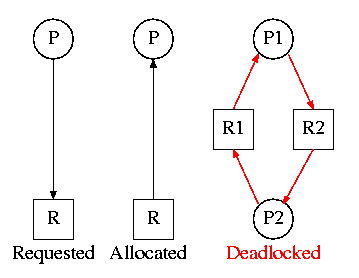

Start Lecture #12
Remark: Whereas we use the term semaphore to mean binary semaphore and explicitly say generalized or counting semaphore for the positive integer version, Tanenbaum uses semaphore for the positive integer solution and mutex for the binary version. Also, as indicated above, for Tanenbaum semaphore/mutex implies a blocking primitive; whereas I use binary/counting semaphore for both busy-waiting and blocking implementations. Finally, remember that in this course our only solutions are busy-waiting.
| Busy wait | block/switch | |
|---|---|---|
| critical | (binary) semaphore | (binary) semaphore |
| semi-critical | counting semaphore | counting semaphore |
| Busy wait | block/switch | |
|---|---|---|
| critical | enter/leave region | mutex |
| semi-critical | no name | semaphore |
You can find some information on barriers in my lecture notes for a follow-on course (see in particular lecture number 16).
We did this previously.
A classical problem from Dijkstra
What algorithm do you use for access to the shared resource (the forks)?
The purpose of mentioning the Dining Philosophers problem without giving the solution is to give a feel of what coordination problems are like. The book gives others as well. The solutions would be covered in a sequel course. If you are interested look, for example here.
Homework: 45 and 46 (these have short answers but are not easy). Note that the second problem refers to fig. 2-20, which is incorrect. It should be fig 2-46.
As in the producer-consumer problem we have two classes of processes.
The problem is to
Variants
Solutions to the readers-writers problem are quite useful in
multiprocessor operating systems and database systems.
The easy way out
is to treat all processes as writers in
which case the problem reduces to mutual exclusion (P and V).
The disadvantage of the easy way out is that you give up reader
concurrency.
Again for more information see the web page referenced above.
Critical Sections have a form of atomicity, in some ways similar to transactions. But there is a key difference: With critical sections you have certain blocks of code, say A, B, and C, that are mutually exclusive (i.e., are atomic with respect to each other) and other blocks, say D and E, that are mutually exclusive; but blocks from different critical sections, say A and D, are not mutually exclusive.
The day after giving this lecture in 2006-07-spring, I found a
modern reference to the same question.
The quote below is from
Subtleties of Transactional Memory Atomicity Semantics
by Blundell, Lewis, and Martin in
Computer Architecture Letters
(volume 5, number 2, July-Dec. 2006, pp. 65-66).
As mentioned above, busy-waiting (binary) semaphores are often
called locks (or spin locks).
... conversion (of a critical section to a transaction) broadens the scope of atomicity, thus changing the program's semantics: a critical section that was previously atomic only with respect to other critical sections guarded by the same lock is now atomic with respect to all other critical sections.
We began with a subtle bug (wrong answer for x++ and x--) and used it to motivate the Critical Section Problem for which we provided a (software) solution.
We then defined (binary) Semaphores and showed that a Semaphore easily solves the critical section problem and doesn't require knowledge of how many processes are competing for the critical section. We gave an implementation using Test-and-Set.
We then gave an operational definition of Semaphore (which is not an implementation) and morphed this definition to obtain a Counting (or Generalized) Semaphore, for which we gave NO implementation. I asserted that a counting semaphore can be implemented using 2 binary semaphores and gave a reference.
We defined the Producer-Consumer (or Bounded Buffer) Problem and showed that it can be solved using counting semaphores (and binary semaphores, which are a special case).
Finally we briefly discussed some classical problems, but did not give (full) solutions.
Skipped.
Skipped, but you should read.


Remark: Deadlocks are closely related to process
management so belong
here, right after chapter 2.
It was here in 2e.
A goal of 3e is to make sure that the basic material gets covered in
one semester.
But I know we will do the first 6 chapters so there is no need for
us to postpone the study of deadlock.
A deadlock occurs when every member of a set of processes is waiting for an event that can only be caused by a member of the set.
Often the event waited for is the release of a resource.
In the automotive world deadlocks are called gridlocks.
For a computer science example consider two processes A and B that each want to print a file currently on a CD-ROM Drive.
Bingo: deadlock!
A resource is an object granted to a process.
Resources come in two types
The interesting issues arise with non-preemptable resources so those are the ones we study.
The life history of a resource is a sequence of
Processes request the resource, use the resource, and release the resource. The allocate decisions are made by the system and we will study policies used to make these decisions.
A simple example of the trouble you can get into.
Recall from the semaphore/critical-section treatment last chapter, that it is easy to cause trouble if a process dies or stays forever inside its critical section. We assume processes do not do this. Similarly, we assume that no process retains a resource forever. It may obtain the resource an unbounded number of times (i.e. it can have a loop forever with a resource request inside), but each time it gets the resource, it must release it eventually.
Definition: A deadlock occurs when a every member of a set of processes is waiting for an event that can only be caused by a member of the set.
Often the event waited for is the release of a resource.
The following four conditions (Coffman; Havender) are necessary but not sufficient for deadlock. Repeat: They are not sufficient.
One can say
If you want a deadlock, you must have these four conditions.
.
But of course you don't actually want a deadlock, so you would more
likely say If you want to prevent deadlock, you need only violate
one or more of these four conditions.
.
The first three are static characteristics of the system and resources. That is, for a given system with a fixed set of resources, the first three conditions are either always true or always false: They don't change with time. The truth or falsehood of the last condition does indeed change with time as the resources are requested/allocated/released.

On the right are several examples of a Resource Allocation Graph, also called a Reusable Resource Graph.
Homework: 5.
Consider two concurrent processes P1 and P2 whose programs are.
P1 P2
request R1 request R2
request R2 request R1
release R2 release R1
release R1 release R2
On the board draw the resource allocation graph for various possible executions of the processes, indicating when deadlock occurs and when deadlock is no longer avoidable.
There are four strategies used for dealing with deadlocks.